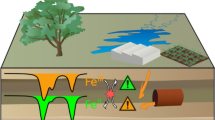Abstract
We have sampled a clay lens with evidence of sulfide reduction from a texturally stratified sandy aquifer at Rømø, Denmark. A minor amount of synthetic, pure 57Fe ferrihydrite was added to this sample and allowed to react for up to three months. The initial sample, the 57Fe ferrihydrite, and samples taken from the reaction mixture were investigated by Mössbauer spectroscopy at temperatures between 15 and 298 K as sampled and following exposure to oxygen. The initial sample only contained Fe(II) (33% of the iron) and Fe(III) in silicates. The Fe(III) in the ferrihydrite is reduced to Fe(II) as evidenced by an increase of this component by bacterial activity. The Fe(II) component remains paramagnetic at temperatures down to 15 K. Similarly to naturally reduced sediments the new-formed Fe(II) is extremely reactive towards molecular oxygen. Following oxidation the reformed Fe(III) is found as ferrihydrite. The bonding of the Fe(II) is by electrostatical bonding (adsorbed) to the layer silicates as evidenced by a temperature scanning of the sample between 80 and 270 K.
Similar content being viewed by others
References
J. Lyngkilde and T.H. Christensen, J. Contam. Hydrol. 10 (1992) 273.
N. van Breemen, in: Iron in Soils and Clay Minerals, eds. J.W. Stucki et al. (Reidel, Dordrecht, 1988) p. 797.
D.E. Canfield, B. Thamdrup and J.W. Hansen, Geochim. Cosmochim. Acta 57 (1993) 3867.
D.R. Lovley, Geomicrobiol. J. 5 (1987) 375.
D.R. Lovley, J.D. Coates, E.L. Blunt-Harris, E.J.P. Phillips and J.C. Woodward, Nature 382 (1996) 445.
M.C. Grantham and P.M. Dove, Geochim. Cosmochim. Acta 60 (1996) 2473.
C.R. Myers and J.M. Myers, J. Bacteriol. 174 (1992) 3429.
S. Seelinger, R. Cord-Ruwisch and B.J. Schink, J. Bacteriol. 180 (1998) 3686.
B. Thamdrup, H. Fossing and B.B. Jørgensen, Geochim. Cosmochim. Acta 60 (1994) 2993.
D. Postma and C. Bender Koch, unpublished results.
E.E. Roden and J.M. Zachara, Environm. Sci. Technol. 30 (1996) 1618.
O. Larsen, Ph.D. dissertation, Department of Geology and Geotechnical Engineering, Technical University of Denmark (1998).
J.E. Kostka, J.W. Stucki, K.H. Nealson and J. Wu, Clays Clay Miner. 40 (1996) 522.
D. Postma, Geochim. Cosmochim. Acta 57 (1993) 5027.
G.E. Brown Jr. et al., Chem Rev. 99 (1999) 77.
J.M.D. Coey, Atomic Energy Review 18 (1980) 73.
R.M. Cornell and U. Schwertmann, The Iron Oxides (VCH Verlag, 1996).
H.C.B. Hansen and C. Bender Koch, Clays Clay Miner. 42 (1994) 170.
D.L. Nagy, in: Mössbauer Spectroscopy of Frozen Solutions, eds. A. Vértes and D.L. Nagy (Akademiai Kiado, Budapest, 1990) p. 114.
Author information
Authors and Affiliations
Rights and permissions
About this article
Cite this article
Larsen, O., Bender Koch, C. Application of 57Fe-enriched synthetic ferrihydrite to speciate the product of bacterial reduction. Hyperfine Interactions 126, 225–234 (2000). https://doi.org/10.1023/A:1012677719558
Issue Date:
DOI: https://doi.org/10.1023/A:1012677719558



